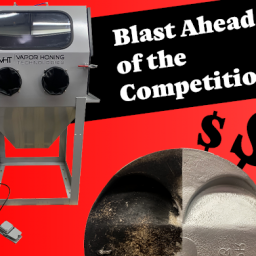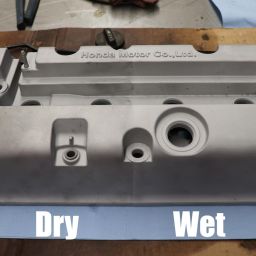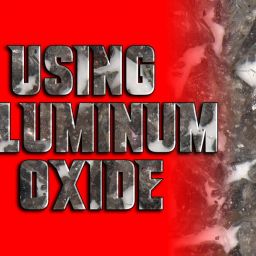Vapor Honing vs Sandblasting: Which One Is for You?
Do you have a mountain of dirty surfaces covering your shop? Or, is your shop full of corrosion-covered parts and in serious need of a good clean and finish? Are you ready for your next project, but unsure where to begin?
You may already be aware that there are several options for cleaning and finishing your surfaces. From sandblasting to vapor honing, the number of available choices is overwhelming. How do you know which one is right for you?
This guide will explore the differences between vapor honing vs sandblasting. It will cover each in detail. With this guide, you’ll be able to make the right decision for your needs.
What is Sandblasting?
To start out, you’ll need to understand the basics of each choice. We’ll begin by exploring sandblasting. Sandblasting is a popular abrasive finishing option.
Sandblasting is also known as abrasive blasting. Essentially, this is when you forcibly shoot a pressurized stream of abrasive material, such as sand, against a surface. Sandblasting uses high pressure to smooth or shapen rough surfaces.
There are many different types of sandblasting depending on which abrasive material you use. These include soda blasting, bead blasting, and shot blasting. Before you decide to use sandblasting, it is important to understand the process and its advantages and disadvantages.
The Abrasive Finishing Process
There are two different types of abrasive finishing processes. Each type is best for particular surfaces. These types include:
Water-Driven
Water-driven processes use pressurized water or other liquid to propel the abrasive material. This type is best suited for preparing brick or concrete surfaces. Usually, professionals use this type to help reduce the deterioration of surfaces.
Vapor honing is a water-driven abrasion method. This leads to less dust, and utilizes different technologies. We’ll dive deeper into this process further down the article.
Air-Driven
Air-driven processes uses compressed gas to propel the abrasive material. This type is best suited for preparing metal surfaces. Generally, this type is used to prevent the buildup of moisture and keep water from intruding on the material’s surface.
Traditional sandblasting is generally air-driven. This means sandblasting generally creates quite a bit of dust. But, in some cases, it can still be useful.
Sandblasting Materials
There are many different types of materials that can be sandblasted. There are also many types of materials that can be used for sandblasting. The type of materials you should use will depend on your project.
What Can Be Sandblasted?
Materials that can be sandblasted include surfaces made out of:
- Glass
- Plastics
- Wood
- Stone/Brick/Rock
- Metal (Steel, Aluminum, Brass, Silver, Etc.)
What Can Be Used in Sandblasting?
Materials that can be used in the sandblasting process to smooth surfaces include:
- Grit
- Glass Beads
- Sand
- Aluminum Oxide
- Garnet
- Black Magic
- Silicon Carbide
- Walnut Shells
- Plastic Pellets
Advantages of Sandblasting
Sandblasting comes with several advantages. Depending on your situation, this might make it a good choice for your next project. Learning the advantages can help you better make your decision.
These advantages include:
Abrasive Action
Sandblasting uses an abrasive, pressurized action to smooth and clean surfaces. These abrasive materials make for an aggressive attack on rough surfaces. If you have a tough job, sandblasting is strong enough to fight back.
Good on Rough Surfaces
Because sandblasting is so aggressive, it is a great option for rough surfaces. Thanks to its powerful action, sandblasting can be good at removing contaminants on tough surfaces. This includes surfaces such as concrete or brick.
A Quick Clean
Once again, the aggressive action of sandblasting means it makes quick work of rough surfaces. Thanks to the high pressure of its abrasive materials, it is generally relatively fast. This means you can work through contaminants quickly.
Less Machinery
Sandblasting is relatively simple. There’s no need for complicated, heavy machinery to get the job done. In fact, sandblasting is a relatively simple process.
Disadvantages of Sandblasting
While sandblasting does have some pretty notable advantages, there are also some drawbacks to consider. It is not the best choice for every project. Sometimes, it can actually be quite damaging.
The disadvantages you should consider include:
Too Rough for Smooth Surfaces
If you need to clean off a smooth surface, sandblasting will be way too rough. Because of the abrasive materials used, you run the risk of damaging smooth surfaces. Vapor honing will probably be a better option for you.
Dangerous for Your Health
Sandblasting generally uses silica in its process. Silica can have dangerous effects on your health and can lead to lung disease. In fact, it has even been banned in many places, such as India.
High Heat
Due to the use of high pressure and abrasive material, sandblasting can quickly become very hot. This creates an added health danger. It can also damage your surfaces if precautions aren’t taken.
Requires Plenty of Protective Gear
Sandblasting is dangerous. In every case, you’ll need to cover your entire body before sandblasting and take many precautions. Sandblasting includes many dangerous hazards to your skin, internal organs, and even your work surface.
Rough on the Environment
Because sandblasting uses abrasive materials in its process, it can lead to environmental damage. This is especially true when inorganic materials, such as plastic or certain metals are used in the blasting process. These small particles can find their way back into the earth, leading to long-term environmental damage.
If you’re looking for a safer surface finishing alternative, vapor honing is a wonderful option. Vapor honing is environmentally friendly and much less harmful to your body.
What is Vapor Honing?
Vapor honing, also known as vapor blasting, is a chemical-free alternative to sandblasting. This keeps users and the environment safe from harmful chemicals and materials. In many cases, this also means vapor honing is a more cost-efficient method than sandblasting.
The vapor honing process begins similarly to sandblasting. Water is mixed with abrasive materials to form a slurry. However, this is where vapor honing technologies begin to differ.
Vapor honing mixes this slurry into a liquid. The evenly-mixed liquid is then pumped into the blasting gun where pressurized air is used to propel the mixture toward the part. The gentle flow of this mixture will smooth away corrosion, leading to a smooth finish on almost any surface.
How Is It Different?
Vapor honing is a much gentler process than sandblasting, both on you and your surfaces. It is easier on your body because it is free from harsh dust and chemicals. For your surfaces, it cleans by flow, not harsh impact.
Vapor blasting uses fine abrasives to clean. This means you are able to clean and degrease surfaces in one easy step without too much fear of damage.
Additionally, there are a wide range of offerings for vapor honing services and equipment. This means, you are able to find the process that works best for your project.
Advantages of Vapor Honing
There are many advantages to utilizing revolutionary vapor honing technologies. Vapor honing can be useful for anyone who does building or construction on a daily basis. This process is cleaner, quicker, and can help you increase output, while spending less.
Vapor honing is both a washing operation and an abrasive blasting operation. This dual-action process has made it a number one choice for all industries. It speeds up the parts cleaning process and is incredibly effective.
Several advantages of vapor honing include:
Environmentally Friendly
Because vapor honing is chemical free, it leaves less of a negative impact on the environment. Where sandblasting can lead to long-term damage, vapor honing is a much cleaner solution. Harsh chemicals won’t be added into the environment, leaving a much smaller footprint.
Safer on Your Body
The lack of chemicals is only one aspect that makes vapor honing safer for you. Additionally, it is dust-free. This limits your chances of developing serious lung conditions, including cancer and other diseases.
Thanks to vapor honing’s clean solutions, your body will be placed at less risk. This also means you won’t need quite as much personal protective equipment. However, you should always utilizate some protective equipment when doing any DIY vapor honing.
Gentler on Surfaces
Vapor honing uses the finest of abrasives. In fact, many of them are no bigger than a human hair. This means, the process of vapor honing is much gentler on your surfaces.
Also, vapor honing utilizes water in its process. This water helps to cushion the impact of the abrasive material. Because of this, abrasive material is much less likely to become impeded in your surfaces.
This can be a major bonus, especially in machinery. If you want to prevent premature part failure, vapor blasting is the way to go.
Lower Operational Costs
Since vapor honing leads to less waste, disposal costs go way down. Operational costs for sandblasting can add up. But, vapor honing is much more efficient, leading to money in your pocket.
Additionally, vapor blasting equipment is generally said to last 8-10 times longer than traditional sandblasting equipment. That’s a lower overhead cost for you in the long run.
Some consumables that last longer with vapor blasting include: blasting nozzles, gloves, windows, and abrasives. Since they last longer with vapor blasting, you’ll spend less of your valuable time and money replacing these.
Disadvantages of Vapor Honing
Vapor honing is a new and promising technology. But, it is not without disadvantages. There aren’t many drawbacks to vapor honing, but there are still a couple to consider.
Higher Purchase Cost
Because vapor honing is relatively new, it can be a bit more pricey. Vapor honing cabinet costs are higher than with traditional sandblasting. However, the equipment and consumables last longer.
Vapor honing might be a more worthwhile long-term investment. Since you’ll spend less money replacing consumables, the higher upfront costs of equipment could be made up for relatively quickly.
Other than a higher upfront cost, there are no real disadvantages to using vapor blasting. Whereas sandblasting can be dangerous, vapor blasting doesn’t feature those same concerns. It is also much gentler on your surfaces and leads to less corrosive damage than sandblasting.
Vapor Honing Services
Vapor honing is a great option for almost every professional. If you need smooth, clean, finished surfaces, vapor honing likely going to be your best bet. But, if you are looking for vapor honing services, you have several options to consider.
Many professionals will choose DIY vapor honing. This means they purchase their own equipment and perform their own vapor honing. DIY vapor honing is a great choice for professionals, who will be performing their vapor honing often.
When performing DIY vapor honing, it’s important you understand the process completely. You should also know how to troubleshoot your projects and equipment. And, it’s important to always be safe when doing any abrasive blasting.
However, you might not need regular vapor honing, or are unfamiliar with the process. In this case, we offer plenty of vapor honing services. Experts and professionals can help you with anything from equipment installation to project completion.
The Right Blasting Solution for You
Now that you are more familiar with the difference between vapor honing vs sandblasting, you’ll be better able to make a decision. In many cases, vapor honing is a cleaner, more efficient option. Sandblasting is more economical in the short term though, so if you’re on a really tight budget, it might have to be your choice.
Remember, though, that vapor honing equipment is a great long-term investment. It has benefits for your health, your environment, and your surfaces. Plus, the efficient technology leads to greater, cleaner output on all your projects.
Vapor honing can be a wonderful long-term tool. We’re here to help with all your vapor honing needs. If you’re looking for more vapor honing help, contact us to find the right expert for you.








